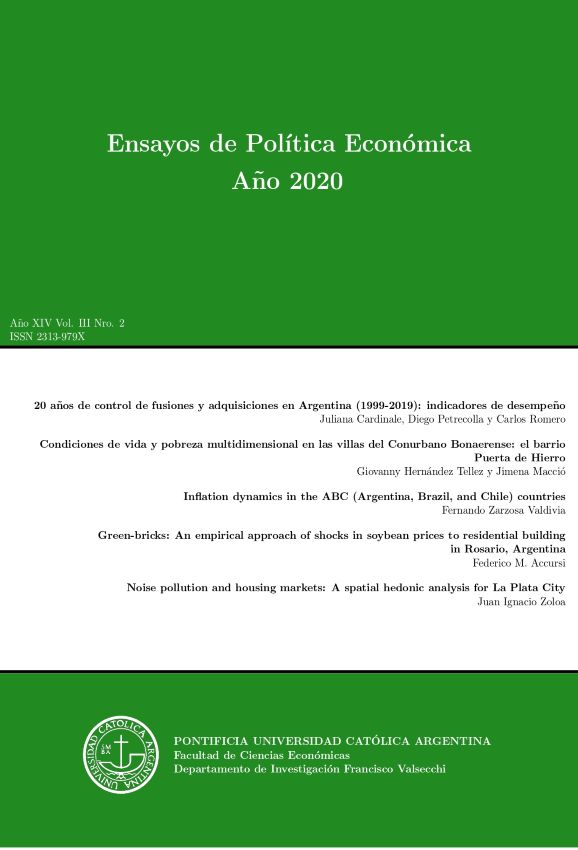Noise pollution and housing markets: A spatial hedonic analysis for La Plata City
DOI:
https://doi.org/10.46553/ensayos.3.2.2020.p129-152Keywords:
noise pollution, housing markets, hedonic price models, ArgentinaAbstract
Several cities around the world are affected by high levels of noise pollution. In fact, noise pollution is one of the main problems affecting the quality of life in cities. In this sense, noise, understood as an environmental stressor, can cause significant health problems, including sleep and learning disorders, memory troubles, lack of motivation and increase in irritability and aggressiveness. This work analyzes the value that individuals place on living in quieter areas. Using hedonic price models, we obtained an accurate assessment of the marginal willingness to pay of individuals to reduce noise pollution. The main result highlight the relevance of this topic: a buyer is willing to pay around 1.9% less for each decibel of noise around the house. Such result is especially relevant in the design of noise mitigation policies, as it determines whether the benefits of the policies designed to reduce noise pollution exceed their implementation
costs.
Downloads
References
Angeletti, K. (2000). Valuación de la contaminación del aire y del ruido por el método de los precios hedónicos: una aplicación a la ciudad de La Plata (Tesis de Maestría en Finanzas Públicas Provinciales y Municipales). Universidad Nacional de La Plata. Facultad de Ciencias Económicas.
Anselin, L. (1988). Spatial Econometrics: Method and Models. Dordrecht: Kluwer Academic Publishers.
Anselin, L. (2005). Exploring spatial data with geoda: A workbook. Department of Geography, University of Illinois, Urbana-Champaign.
Anselin, L. & Le Gallo, J. (2006). “Interpolation of air quality measures in hedonic house price models: Spatial aspects”. Spatial Economic Analysis, 1(1), 31-52.
Bateman, I., Day, B., Lake, I., & Lovett, A. (2000). The effect of road traffic on residential property values: A literature review and hedonic pricing study. Report to The Scottish Office, Development Department, Edinburgh, School of Environmental Sciences, University of East Anglia, Norwich.
Bertrand, N. F. (1997). Meta-analysis of studies of willingness to pay to reduce traffic noise. MSc dissertation, University College London.
Case, K. & Shiller, R. (2003). “Is there a bubble in the housing market?”. Brookings Papers on Economic Activity, 2, 299–362.
Christiaensen, L. & Kanbur, R. (2017). “Secondary towns and poverty reduction: Refocusing the urbanization agenda.” Annual Review of Resource Economics. 9, 405-419.
Conte Grand, M. (2001). Una primera aproximación a la valuación hedónica de la contaminación en Buenos Aires. Serie Documentos de Trabajo No. 207. Universidad del CEMA.
Day, B. (2001). The theory of hedonic markets: Obtaining welfare measures for changes in environmental quality using hedonic market data. Economics for the Environment Consultancy (Eftec), London.
Diem, J. (2003). “A critical examination of ozone mapping from a spatial-scale perspective”. Environmental pollution, 125(3), 369–383.
Harrison, D. & Rubinfeld, D. (1978). “Hedonic housing prices and the demand for clean air”. Journal of environmental economics and management, 5(1), 81–102.
Hawkins, R. (1999). Review of studies on external costs of noise. prepared. Environment Protection Economics Division, DETR (DEFRA).
Herrera, M. (2015). Econometría espacial usando stata. Breve guía aplicada para datos de corte transversal. Documentos de Trabajo del IELDE, (13). Documento Técnico Nº 1.
Hurtado, M., Giménez, J., Cabral, M., Silva, M., Martinez, O., Camilion, M., Sanchez, C., Gebhard, J., Forte, L., Boff, L., Crincoli, A., & Lucesoli, H. (2006). Análisis ambiental del partido de La Plata: Aportes al ordenamiento territorial. Consejo Federal de Inversiones, Facultad de Ciencias Naturales y Museo, La Plata.
Kelejian, H. & Prucha, I. (2007). “Hac estimation in a spatial framework”. Journal of Econometrics, 140, 131–154.
Kim, C., Phipps, T., & Anselin, L. (2003). “Measuring the benefits of air quality improvement: a spatial hedonic approach”. Journal of environmental economics and management, 45(1), 24–39.
LeSage, J. & Pace, K. (2009). Introduction to spatial econometrics. Chapman and Hall/CRC editor; First Edition.
Navrud, S. (2002). The state of the art on economic valuation of noise. Final Report to European Commission DG Environment.
Nelson, J. (2004). “Meta-analysis of airport noise and hedonic property values”. Journal of Transport Economics and Policy, 38(1), 1–27.
Rabassa. M. & Zoloa, J.I (2016). “Flood Risks and Housing Prices: A Spatial Hedonic Model for La Plata”. Environment and Development Economics, 21(4), 464-489.
Ridker, R. & Henning, J. (1967). “The determinants of residential property values with special reference to air pollution”. The Review of Economics and Statistics, 49(2), 246–257.
Rosen, S. (1974). “Hedonic prices and implicit markets: product differentiation in pure competition”. Journal of Political Economy, 1(82), 34–55.
UN (2018). World Population Prospects. Department of Economic and Social Affairs Population Dynamics. United Nations. Available at https://population.un.org/wpp/
WHO (2011). Burden of disease from environmental noise. Quantification of healthy life years lost in Europe. World Health Organization (WHO).
Zoloa, J.I. (2015). Tópicos en el mercado inmobiliario: Un análisis desde la econometría espacial (Tesis de Doctorado en Economía).Universidad Nacional de La Plata, Facultad de Ciencias Económicas.
Downloads
Published
How to Cite
Issue
Section
License







 Ensayos de Política Económica
Ensayos de Política Económica